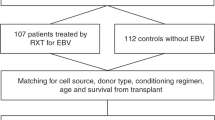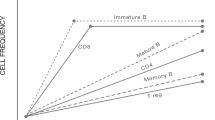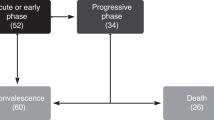Abstract
Paraproteinaemia following allo-SCT is common. We analysed 91 consecutive patients undergoing allo-SCT; conditioning included alemtuzumab in 42% of the patients. Paraproteinaemia incidence at 2 years was 32%. In univariate analysis paraproteinaemia was associated with unrelated donor, age, recipient seropositivity for CMV and alemtuzumab conditioning (hazard ratio (HR) 3.93, P=0.0006). Paraproteinaemia was not associated with haematological diagnosis; disease status at transplant; varicella zoster, herpes simplex or EBV serology; reduced-intensity vs myeloablative conditioning or GVHD. CMV reactivation—more frequent in alemtuzumab recipients—was associated with paraproteinaemia (HR 7.52, P<0.0001). In multivariate analysis, only increasing age (HR 1.04 per year, P=0.048) and CMV reactivation (HR 5.74, P=0.001) were significantly associated with paraproteinaemia. Alemtuzumab without CMV reactivation, however, resulted in significantly more paraproteinaemia, suggesting an effect that is independent of CMV reactivation. OS was poorer in patients with paraproteinaemia (HR 2.54, P=0.04) and relapse increased (HR 2.38, P=0.087). Paraproteinaemia was not significantly independently associated with decreased survival on multivariate analysis. Post transplant paraproteinaemia is associated with CMV reactivation, is more frequent in alemtuzumab-conditioned transplants and is not associated with improved OS.
This is a preview of subscription content, access via your institution
Access options
Subscribe to this journal
Receive 12 print issues and online access
$259.00 per year
only $21.58 per issue
Buy this article
- Purchase on Springer Link
- Instant access to full article PDF
Prices may be subject to local taxes which are calculated during checkout




Similar content being viewed by others
References
Kyle RA, Therneau TM, Rajkumar SV, Larson DR, Plevak MF, Offord JR et al. Prevalence of monoclonal gammopathy of undetermined significance. N Engl J Med 2006; 354: 1362–1369.
Pruzanski W, Cowan DH, Merrett RA, Freedman MH . IgG-1(kappa) M component after bone marrow transplantation. Clin Immunol Immunopathol 1973; 1: 311–318.
Rádl J, Dooren LJ, Eijsvoogel VP, van Went JJ, Hijmans W . An immunological study during post-transplantation follow-up of a case of severe combined immunodeficiency. Clin Exp Immunol 1972; 10: 367–382.
Fischer AM, Simon F, Deist FL, Blanche S, Griscelli C, Fischer A . Prospective study of the occurrence of monoclonal gammapathies following bone marrow transplantation in young children. Transplantation 1990; 49: 731–735.
Gerritsen EJ, van Tol MJ, Lankester AC, van der Weijden-Ragas CP, Jol-van der Zijde CM, Oudeman-Gruber NJ et al. Immunoglobulin levels and monoclonal gammopathies in children after bone marrow transplantation. Blood 1993; 82: 3493–3502.
Hammarström L, Smith CI . Frequent occurrence of monoclonal gammopathies with an imbalanced light-chain ratio following bone marrow transplantation. Transplantation 1987; 43: 447–449.
Hebart H, Einsele H, Klein R, Fischer I, Bühler S, Dietz K et al. CMV infection after allogeneic bone marrow transplantation is associated with the occurrence of various autoantibodies and monoclonal gammopathies. Br J Haematol 1996; 95: 138–144.
Lim ZY, Ingram W, Brand R, Akthari M, Milojkovic D, Ho AY et al. Clonal gammopathies following alemtuzumab-based reduced intensity conditioning haematopoietic stem cell transplantation: association with chronic graft-versus-host disease and improved overall survival. Bone Marrow Transplant 2007; 40: 747–752.
Mitus AJ, Stein R, Rappeport JM, Antin JH, Weinstein HJ, Alper CA et al. Monoclonal and oligoclonal gammopathy after bone marrow transplantation. Blood 1989; 74: 2764–2768.
Nagashima T, Muroi K, Kawano-Yamamoto C, Komatsu N, Ozawa K . Paraproteinemia after hematopoietic stem cell transplantation. Leuk Lymphoma 2004; 45: 135–137.
Hovenga S, de Wolf JT, Guikema JE, Klip H, Smit JW, Smit Sibinga CT et al. Autologous stem cell transplantation in multiple myeloma after VAD and EDAP courses: a high incidence of oligoclonal serum Igs post transplantation. Bone Marrow Transplant 2000; 25: 723–728.
Maisnar V, Tichý M, Smolej L, Zák P, Radocha J, Palicka V et al. Isotype class switching after transplantation in multiple myeloma. Neoplasma 2007; 54: 225–228.
Zent CS, Wilson CS, Tricot G, Jagannath S, Siegel D, Desikan KR et al. Oligoclonal protein bands and Ig isotype switching in multiple myeloma treated with high-dose therapy and hematopoietic cell transplantation. Blood 1998; 91: 3518–3523.
Badley AD, Portela DF, Patel R, Kyle RA, Habermann TM, Strickler JG et al. Development of monoclonal gammopathy precedes the development of Epstein-Barr virus-induced posttransplant lymphoproliferative disorder. Liver Transpl Surg 1996; 2: 375–382.
Chakalarovski C, Lang P, Buisson C, Bourgeon B, Intrator L, Deforge L et al. Monoclonal immunoglobulins in patients with renal transplants: characterization, evolution and risk factors. Transpl Int 1992; 5 (Suppl 1): S23–S25.
Drouet E, Chapuis-Cellier C, Bosshard S, Verniol C, Niveleau A, Touraine JL et al. Oligo-monoclonal immunoglobulins frequently develop during concurrent cytomegalovirus (CMV) and Epstein-Barr virus (EBV) infections in patients after renal transplantation. Clin Exp Immunol 1999; 118: 465–472.
Monk J, Calvin J, Price CP, Wreghitt TG . Oligoclonal banding in serum from heart-transplant recipients. Clin Chem 1989; 35: 431–434.
Myara I, Quenum G, Storogenko M, Tenenhaus D, Guillemain R, Moatti N . Monoclonal and oligoclonal gammopathies in heart-transplant recipients. Clin Chem 1991; 37: 1334–1337.
Lemoine A, Pham P, Azoulay D, Saliba F, Emile JF, Saffroy R et al. Detection of gammopathy by serum protein electrophoresis for predicting and managing therapy of lymphoproliferative disorder in 911 recipients of liver transplants. Blood 2001; 98: 1332–1338.
Pageaux GP, Bonnardet A, Picot MC, Perrigault PF, Coste V, Navarro F et al. Prevalence of monoclonal immunoglobulins after liver transplantation: relationship with posttransplant lymphoproliferative disorders. Transplantation 1998; 65: 397–400.
Touchard G, Pasdeloup T, Parpeix J, Hauet T, Bauwens M, Dumont G et al. High prevalence and usual persistence of serum monoclonal immunoglobulins evidenced by sensitive methods in renal transplant recipients. Nephrol Dial Transplant 1997; 12: 1199–1203.
Bühler S, Laitinen K, Holthöfer H, Järvinen A, Schauman KO, Hedman K . High rate of monoclonal gammopathy among immunocompetent subjects with primary cytomegalovirus infection. Clin Infect Dis 2002; 35: 1430–1433.
Shulman HM, Sullivan KM, Weiden PL, McDonald GB, Striker GE, Sale GE et al. Chronic graft-versus-host syndrome in man. A long-term clinicopathologic study of 20 Seattle patients. Am J Med 1980; 69: 204–217.
Kidd IM, Fox JC, Pillay D, Charman H, Griffiths PD, Emery VC . Provision of prognostic information in immunocompromised patients by routine application of the polymerase chain reaction for cytomegalovirus. Transplantation 1993; 56: 867–871.
Kaplan EL, Meier P . Non-parametric estimation from incomplete observations. J Am Stat Assoc 1958; 53: 457–481.
Giralt S . The role of alemtuzumab in nonmyeloablative hematopoietic transplantation. Semin Oncol 2006; 33: S36–S43.
Chakrabarti S, Mackinnon S, Chopra R, Kottaridis PD, Peggs K, O’Gorman P et al. High incidence of cytomegalovirus infection after nonmyeloablative stem cell transplantation: potential role of Campath-1H in delaying immune reconstitution. Blood 2002; 99: 4357–4363.
Shapiro RS, McClain K, Frizzera G, Gajl-Peczalska KJ, Kersey JH, Blazar BR et al. Epstein-Barr virus associated B cell lymphoproliferative disorders following bone marrow transplantation. Blood 1988; 71: 1234–1243.
D’Sa S, Peggs K, Pizzey A, Verfuerth S, Thuraisundaram D, Watts M et al. T- and B-cell immune reconstitution and clinical outcome in patients with multiple myeloma receiving T-cell-depleted, reduced-intensity allogeneic stem cell transplantation with an alemtuzumab-containing conditioning regimen followed by escalated donor lymphocyte infusions. Br J Haematol 2003; 123: 309–322.
Peggs KS, Verfuerth S, Pizzey A, Khan N, Moss P, Goldstone AH et al. Reconstitution of T-cell repertoire after autologous stem cell transplantation: influence of CD34 selection and cytomegalovirus infection. Biol Blood Marrow Transplant 2003; 9: 198–205.
Acknowledgements
We would like to thank Kevin Paddon for assistance with laboratory data collection and the staff of the Immunology Laboratory at the Churchill Hospital Oxford for performing serum electrophoresis and immunofixation assays. This work was funded by the NIHR Biomedical Research Centre Programme.
Author information
Authors and Affiliations
Corresponding author
Ethics declarations
Competing interests
The authors declare no conflict of interest.
Rights and permissions
About this article
Cite this article
Medd, P., Littlewood, S., Danby, R. et al. Paraproteinaemia after allo-SCT, association with alemtuzumab-based conditioning and CMV reactivation. Bone Marrow Transplant 46, 993–999 (2011). https://doi.org/10.1038/bmt.2010.244
Received:
Revised:
Accepted:
Published:
Issue Date:
DOI: https://doi.org/10.1038/bmt.2010.244
Keywords
This article is cited by
-
Correlation between paraproteinaemia and viral reactivation after allo-SCT
Bone Marrow Transplantation (2012)
-
Response to ‘Correlation between paraproteinaemia and viral reactivation after allo-SCT’
Bone Marrow Transplantation (2012)



